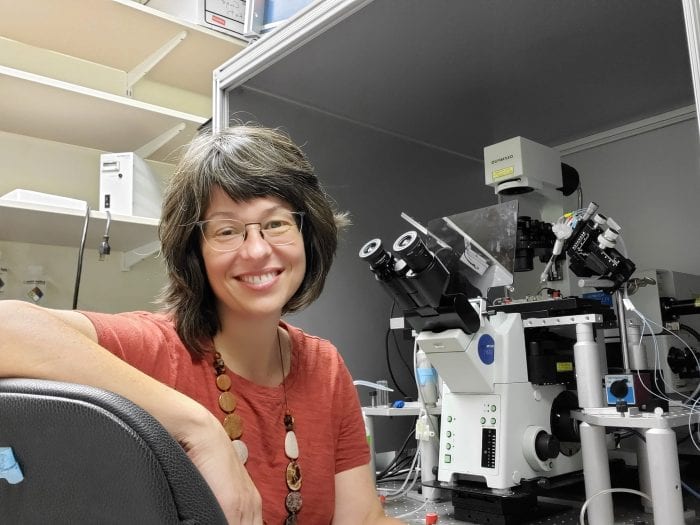By Daniel Dunaief
Children knock on the door of 1313 Gluto Lane, a favorite house for Halloween. The resident, known for providing coveted confections at a rapid rate, immediately comes to the door, asks no questions about the Halloween costumes that might slow the process down and, with almost super-human speed, dumps candy into open bags and closes the door.
Word spreads about the house on Gluto Lane. Soon, the doorbell rings at a furious pace, with children eager to get the best candy of this difficult year and move on to the next house.
At first, with Trick or Treaters coming at a regular pace, the process works, but then, something goes awry, creepy music begins and the door doesn’t open.
That’s what’s happening in bipolar retinal cells in the goldfish Christina Joselevitch, a Postdoctoral Associate in the Neurobiology and Behavior Department at Stony Brook University’s Renaissance School of Medicine, is studying.
Known for their incredible speed at releasing neurotransmitters stored in circular vesicles, these bipolar retinal cells go through a depression in which they can’t release the neurotransmitter glutamate despite repeated signals for the release of the neurotransmitter.
“When you stimulate those cells very strongly, with two stimuli close apart, they suffer depression,” Joselevitch said. “Nobody knew why, if they’re able to signal constantly, they should suffer from depression.
To be sure, Joselevitch was working with extreme stimulation to probe the limits of the system and understand its underpinnings. This is not necessarily how these cells work. She said the researchers don’t know if retinal neurons experience synaptic depression under normal conditions and what function depression would have in bipolar cell physiology, in vision or in signaling processing in general.
In a recent publication in the Journal of Neuroscience, Joselevitch described at least two processes that contribute to this slowdown, which she describes as the rate limiting steps. The vesicles need to get to the membrane and they need to get ready to mature before they are release. Once vesicles move towards the cell membrane, they don’t immediately fuse and send their neurotransmitter into the synapse between cells. In some cells, such as the retinal photoreceptors and bipolar cells and in hair cells of the ear and lateral line in fish and in cells of the pineal gland, they gather in a ribbon close to calcium entry points.
Scientists have two theories of the ribbon function. The first is that it could act as a conveyor belt and speed up vesicle priming and delivery to the membrane and the second is that it could set a constant pace for vesicle delivery.
Joselevitch’s results suggest that the vesicles attach to the ribbon, where they go through a maturation process. These paired-pulse depressions don’t just occur in fish: they also affect the ability of mammalian cells to respond to a second stimulus.
These cellular phenomena show the limits of the system. Indeed, Joselevitch likened the process to a car that has reached its maximum speed. Pushing down harder or more on the accelerator won’t enable further acceleration.
The impact of this work is “broad,” she said. Studying this process could enable a stronger awareness of the steps in fast-acting processes in the nervous system. Such research could also provide an understanding about processes that go awry in various neurological diseases.
In an email, Professor Lonnie Wollmuth, who is the principal investigator for the Stony Brook lab in which Joselevitch works, described Joselevitch as “invaluable to our on-going efforts to study presynaptic mechanisms in the retina.” He wrote that she was an “outstanding and very careful scientist” who is “passionate” about her research and has served as a mentor for others in the lab. Joselevitch has been working in Wollmuth’s lab for about 16 months.
Synaptic transmission is fundamental to all brain function, Wollmuth explained. “Changes in the strength of synaptic transmission underlie basic higher order brain functions like learning and memory,” the Stony Brook Professor wrote. Joselevitch’s experiments “reveal mechanisms of presynaptic vesicle release at all synapses and provide novel insights into the processing of vesicles at ribbon synapses.”
Based on Joselevitch’s work, Wollmuth’s lab has submitted a large National Institutes of Health grant to the National Eye Institute to study the molecular components of presynaptic release in the retina. She has also started to integrate her work with Alzheimer’s Disease, as proteins found in that disease disrupt the molecular machinery involved in presynaptic release.
A native of Brazil, Joselevitch has been at Stony Brook University since last July. She is on sabbatical with the University of São Paulo. She is hoping to participate in these studies in New York for a few more years.
She said she was “always a nerd,” and liked to study languages. With varying levels of proficiency, she speaks five languages: Portuguese, English, German, Dutch, and Spanish. At one point, she wanted to be an astronaut, but her mother Carmen dissuaded her from pursuing that interest.
Joselevitch had planned to return to Brazil to see her family in April, but had to cancel that plan because of a travel ban from the COVID-19 pandemic. She said her parents have been “good sports” and her father has bought a smartphone so he can talk through Skype or WhatsApp with his scientist daughter.
Joselevitch enjoys biking, hiking, singing and playing guitar and has been productive during the pandemic, writing papers and proposals. Stony Brook is nominating her work for consideration for the Warren Alpert Distinguished Scholar Award.
Wollmuth wrote that Joselevitch’s research forms “the foundation for future experiments to address the molecular components of vesicle dynamics.” Once they are identified, researchers can modulate and protect them in brain diseases.
Citing author James Joyce, Joselevitch explained her focus on neurons in the fish eye, which, she hopes, may lead to a broader understanding of neurology and disease. When asked why he wrote about Dublin when he could describe other places he’s visited, Joyce responded, “In the particular is contained the universal.”





